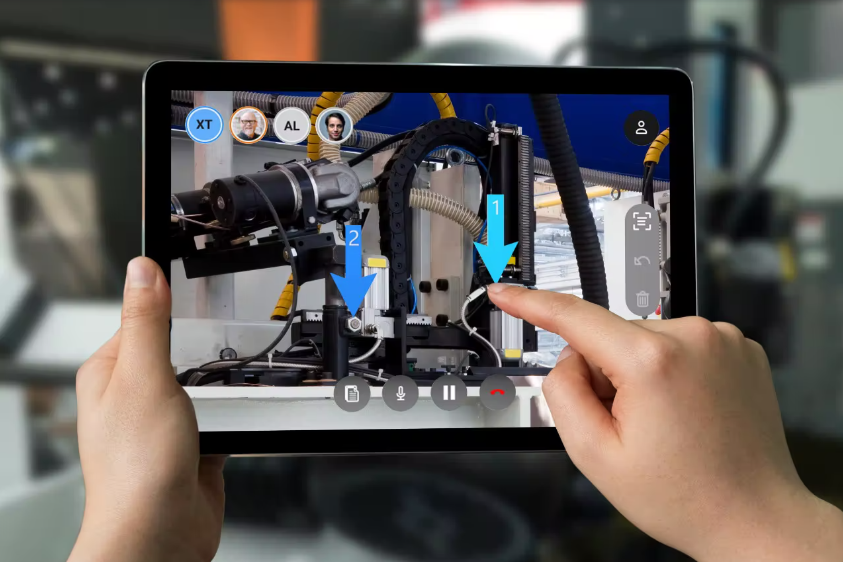Augmented Reality (AR): Safeguarding Human Capital in the Digital Age

Title: Augmented Reality (AR): Safeguarding Human Capital in the Digital Age
In the quest for innovation and technological advancement, businesses are increasingly turning to cutting-edge solutions to protect their most valuable asset: human capital. While Artificial Intelligence (AI) has long been hailed as the harbinger of change, Augmented Reality (AR) emerges as a formidable contender in the realm of safeguarding human resources. With its unique capabilities, AR offers a myriad of benefits that complement and enhance traditional AI-driven approaches, fostering a safer and more productive environment for employees. Let's delve into the distinct advantages of investing in AR technology to protect human capital.
Enhanced Training and Skill Development:
AR transcends conventional training methods by providing immersive, interactive experiences. Through AR simulations, employees can engage in lifelike scenarios, mastering complex tasks in a risk-free environment. Whether it's training for hazardous situations, machinery operation, or customer service protocols, AR empowers individuals to learn and refine skills with unprecedented realism. This not only boosts competence but also instills confidence, reducing the likelihood of errors and accidents in the workplace.
Improved Safety Protocols:
Safety remains a paramount concern across industries. AR equips workers with real-time guidance and information, overlaying relevant data onto their physical environment. For instance, technicians servicing machinery can access maintenance manuals and troubleshooting instructions directly through AR-enabled smart glasses, ensuring adherence to safety protocols without diverting attention from the task at hand. By providing instant access to critical information, AR mitigates risks and fosters a culture of safety within organizations.
Remote Assistance and Collaboration:
In an era of remote work and global connectivity, AR bridges geographical barriers by facilitating remote assistance and collaboration. Through AR-enabled platforms, experts can remotely guide field technicians or frontline workers, offering real-time support and troubleshooting solutions. This not only expedites problem-solving but also minimizes downtime, optimizing operational efficiency. Additionally, AR enables collaborative design and prototyping, allowing teams dispersed across locations to work seamlessly on projects, thereby leveraging collective expertise and preserving human capital resources.
Ergonomic Advancements:
Ergonomic injuries and musculoskeletal disorders pose significant risks to employee well-being and productivity. AR addresses these concerns by introducing ergonomic simulations and assessments. By analyzing workplace ergonomics through AR visualization, organizations can identify potential hazards and implement preventive measures to mitigate ergonomic risks. Furthermore, AR can assist in designing ergonomic workstations tailored to individual needs, thereby promoting employee health and reducing absenteeism due to work-related injuries.
Enhanced Customer Interaction:
Beyond internal operations, AR enhances customer-facing interactions, thereby safeguarding the reputation and goodwill of businesses. Retailers utilize AR applications to offer immersive shopping experiences, allowing customers to visualize products in their intended environment before making a purchase. Similarly, service providers leverage AR to deliver personalized experiences, enhancing customer satisfaction and loyalty. By prioritizing customer engagement and satisfaction, businesses safeguard their brand value and maintain a loyal customer base, indirectly preserving human capital by ensuring sustained business growth.
While AI undoubtedly revolutionizes various aspects of business operations, investing in Augmented Reality presents a compelling proposition for safeguarding human capital in the digital age. By leveraging AR's immersive experiences, real-time guidance, and collaborative capabilities, organizations can empower their workforce, enhance safety protocols, and optimize operational efficiency. As businesses navigate the complexities of a rapidly evolving landscape, AR emerges as a powerful ally in preserving and protecting the invaluable resource of human capital.
Success Stories:
How a Warehouse Frontline Workforce has been empowered and upskilled thanks to AR https://www.nextarsolutions.net/case-study-sap-ewm-teamviewer-frontline-warehouse
The High Cost of Warehouse Employee Turnover: A Silent Drain on Company Resources
Employee turnover is a significant concern for businesses across all industries, but its impact is particularly pronounced in the warehouse sector. With the demanding nature of warehouse work, including physical labor, long hours, and sometimes harsh working conditions, retaining skilled employees can be a constant challenge. The cost of high turnover rates in warehouses goes far beyond the direct expenses of hiring and training new staff. It affects productivity, morale, and ultimately, the bottom line of the company.
Direct Costs
1. Recruitment and Hiring: The process of recruiting, interviewing, and onboarding new employees incurs expenses in terms of HR personnel time, advertising, background checks, and other related costs.
2. Training: Once hired, new warehouse employees require training to familiarize themselves with company procedures, safety protocols, and equipment operation. This investment in training becomes wasted when employees leave shortly after completing their training.
3. Loss of Productivity: Vacant positions and new hires typically result in a temporary decrease in productivity as the remaining employees pick up the slack and new hires get up to speed. This can lead to delays in order fulfillment, increased error rates, and decreased customer satisfaction.
Indirect Costs
1. Impact on Morale: High turnover rates can demoralize remaining employees, leading to decreased job satisfaction, increased stress, and lower morale. This, in turn, can further contribute to turnover as existing employees seek better opportunities elsewhere.
2. Knowledge Loss: Experienced employees possess valuable institutional knowledge about warehouse operations, inventory management, and customer preferences. When they leave, this knowledge walks out the door with them, potentially leading to inefficiencies and errors that can impact the company's reputation and bottom line.
3. Safety Concerns: New employees are more likely to be involved in workplace accidents and injuries due to their lack of experience. This can result in increased workers' compensation claims, medical expenses, and potential legal liabilities for the company.
4. Customer Impact: Inconsistencies in staffing levels and decreased productivity can lead to delayed order processing and shipping, which may ultimately result in dissatisfied customers, lost sales, and damage to the company's reputation.
Quantifying the Cost
While the exact cost of warehouse employee turnover varies depending on factors such as industry, company size, and location, research suggests that it can be substantial. According to a study by the Center for American Progress, the cost of replacing an employee can range from 16% to 213% of their annual salary, depending on the position and level of expertise required.
For warehouse workers, who often earn hourly wages rather than salaries, the cost of turnover may be lower in terms of direct monetary expenses but can still be significant when considering the impact on productivity, safety, and customer satisfaction.
Addressing the Issue
To mitigate the impact of high turnover rates in warehouses, companies can take several proactive measures:
1. Invest in Employee Development: Providing opportunities for skill development, advancement, and career growth can increase employee engagement and loyalty.
2. Improve Working Conditions: Creating a safe, comfortable work environment with proper equipment and adequate breaks can help reduce turnover by enhancing employee satisfaction and well-being.
3. Offer Competitive Compensation and Benefits: Fair wages, performance-based incentives, and comprehensive benefits packages can attract and retain top talent in a competitive job market.
4. Enhance Recruitment and Onboarding Processes: Streamlining recruitment, hiring, and onboarding processes can reduce the time and resources spent on bringing new employees up to speed while ensuring a positive experience for candidates and new hires.
In conclusion, while the true cost of warehouse employee turnover may be difficult to quantify precisely, its impact on company resources, productivity, and morale is undeniable.
By addressing the root causes of turnover, implementing strategies to retain skilled employees, and shortening their new hire's ramp-up period, companies can mitigate these costs and foster a more stable and successful workforce in the warehouse industry.
Success Stories:
How a giant Distributor has reduced their production cost for new hires by shortening the trail period from 30 days to 8 hours (-93%)
https://www.nextarsolutions.net/case-study-sap-ewm-teamviewer-frontline-warehouse
The Critical Balance: Picking Accuracy vs. Cost of Mistakes in Warehouse Order Management

In the fast-paced world of warehouse order management, the importance of picking accuracy cannot be overstated. Every item that is picked and shipped must be the correct product, quantity, and quality to ensure customer satisfaction and maintain the reputation of the company. However, achieving high levels of picking accuracy often comes with associated costs, leading to a delicate balance between accuracy and efficiency.
The Significance of Picking Accuracy
1. Customer Satisfaction: Accuracy in picking directly impacts customer satisfaction. Sending the wrong items or quantities can lead to frustration, delayed projects, and potentially lost business. In today's competitive market, customer experience can make or break a company's reputation.
2. Reduced Returns and Replacements: Accurate picking minimizes the likelihood of returns and replacements due to incorrect orders. This not only saves the company money on shipping and restocking fees but also preserves valuable customer relationships.
3. Inventory Management: Picking accuracy is essential for maintaining accurate inventory records. Errors in picking can lead to discrepancies between actual and recorded inventory levels, leading to stockouts, overstock situations, and ultimately, lost sales.
4. Operational Efficiency: Accurate picking streamlines warehouse operations by reducing the time and resources spent on correcting mistakes, processing returns, and reshipping orders. This allows the warehouse to operate more efficiently and fulfill orders in a timely manner.
The Cost of Mistakes
1. Direct Costs: Mistakes in picking incur direct costs such as the value of the incorrect items picked, additional labor required to correct the error, and potential shipping expenses for returns and replacements.
2. Indirect Costs: Beyond the immediate financial impact, mistakes in picking can result in indirect costs such as damage to the company's reputation, loss of customer trust, and decreased employee morale.
3. Operational Disruptions: Mistakes in picking can disrupt warehouse operations, leading to delays in order fulfillment, increased workload for other employees, and potential bottlenecks in the shipping process.
Finding the Balance
While achieving 100% picking accuracy may seem like an ideal goal, it is often not practical or cost-effective. Balancing picking accuracy with the costs associated with mistakes requires careful consideration of various factors:
1. Technology and Automation: Investing in technology and automation solutions such as barcode scanning, RFID systems, and automated picking equipment can improve accuracy while reducing the likelihood of errors.
2. Training and Quality Control: Providing comprehensive training to warehouse staff and implementing robust quality control measures can help minimize human errors in picking.
3. Cost-Benefit Analysis: Conducting regular cost-benefit analyses to evaluate the trade-offs between picking accuracy and the costs of mistakes can help warehouse managers make informed decisions and prioritize investments in process improvements.
4. Continuous Improvement: Adopting a culture of continuous improvement and implementing feedback mechanisms can help identify areas for improvement in the picking process and drive ongoing enhancements.
In conclusion, while the pursuit of picking accuracy is crucial for ensuring customer satisfaction and operational efficiency, warehouse managers must also consider the costs associated with mistakes and find the right balance to optimize performance and profitability. By investing in technology, training, and process improvements, companies can achieve higher levels of accuracy while minimizing the financial and operational impact of errors in warehouse order management.
Success Stories:
How Coca-Cola and the Pharma Distributor Nardo have revolutionized their Warehouse Strategy https://www.nextarsolutions.net/case-study-sap-ewm-teamviewer-frontline-warehouse
.
The 7 Challenges on Field Operations: a Crucial Test for Modern Companies
In the ever-evolving landscape of business, field operations stand as the frontline for companies engaged in industries ranging from construction and logistics to utilities and telecommunications. These operations encompass a broad spectrum of activities conducted outside the traditional office environment, often involving tasks such as service delivery, maintenance, inspections, and installations.
While advancements in technology have streamlined many aspects of field operations, companies continue to grapple with a myriad of challenges that can impede efficiency, productivity, and ultimately, profitability. In this article, we'll delve into some of the most prevalent obstacles faced by companies in their field operations and explore potential strategies to overcome them.
Resource Allocation and Optimization: One of the primary challenges for companies with field operations is effectively managing and optimizing resources. This includes personnel, vehicles, equipment, and inventory. Poor resource allocation can lead to inefficiencies, increased costs, and missed opportunities. Implementing robust scheduling and routing algorithms, along with real-time tracking and monitoring systems, can help companies allocate resources more effectively and respond promptly to changing demands.
Communication and Coordination: Field operations often involve teams spread across different locations, making communication and coordination a significant challenge. Ensuring seamless communication between field workers, supervisors, and support staff is essential for timely decision-making and problem resolution. Adopting communication tools such as mobile apps, instant messaging platforms, and collaboration software can facilitate real-time communication and enhance coordination among dispersed teams.
Safety and Compliance: Maintaining safety standards and regulatory compliance is paramount in field operations, where workers are frequently exposed to various hazards and risks. Failure to adhere to safety protocols not only jeopardizes the well-being of workers but also exposes companies to legal liabilities and reputational damage. Investing in comprehensive training programs, providing personal protective equipment (PPE), conducting regular safety audits, and leveraging IoT-enabled devices for remote monitoring can help mitigate safety risks and ensure compliance with regulations.
Data Management and Integration: Field operations generate vast amounts of data, including work orders, inspection reports, customer feedback, and equipment diagnostics. Managing and integrating this data efficiently can be a daunting task for companies, especially without robust data management systems in place. Adopting cloud-based platforms, implementing robust data analytics tools, and integrating disparate systems through APIs (Application Programming Interfaces) can enable companies to harness the power of data to drive informed decision-making and process optimization.
Field Service Technician Shortage: A looming challenge for many companies is the shortage of skilled field service technicians. With an aging workforce and a lack of qualified talent entering the field, companies are struggling to fill vacant positions and maintain service levels. To address this challenge, companies can invest in training and development programs to upskill existing employees, forge partnerships with educational institutions to attract new talent, and leverage technology such as augmented reality (AR) for remote assistance and knowledge transfer.
Environmental Sustainability: In an era of increasing environmental awareness and sustainability concerns, companies are under pressure to minimize the environmental footprint of their field operations. This includes reducing fuel consumption, minimizing waste generation, and adopting eco-friendly practices wherever possible. Embracing alternative fuels, optimizing route planning to reduce mileage, and incorporating energy-efficient technologies into equipment and vehicles are some strategies companies can employ to promote environmental sustainability in their field operations.
Customer Expectations and Experience: In today's competitive marketplace, delivering exceptional customer service is non-negotiable. Field operations play a crucial role in shaping the overall customer experience, from service delivery and response times to communication and problem resolution. Companies must prioritize customer satisfaction by empowering field teams with the tools and training they need to deliver prompt, personalized service and exceed customer expectations at every touchpoint.
In conclusion, while field operations present a myriad of challenges for companies, they also represent an opportunity for innovation, growth, and differentiation. By addressing these challenges proactively and leveraging technology, data-driven insights, and a customer-centric approach, companies can optimize their field operations, drive operational excellence, and gain a competitive edge in today's dynamic business environment.
Read our Success Stories:
How Marposs is executing their Post Sale Support with AR: https://www.nextarsolutions.net/bars-case-study-post-sale-support-marposs
How Cimbali Group is remotely supporting over 700 local partners over the world: https://www.nextarsolutions.net/bars-case-study-teamviewer-iot-remote-support-cimbali-group
Empowering Retail Success: The Vital Role of IoT Remote Support "
In the fast-paced world of retail, staying ahead of the competition requires more than just offering great products—it demands seamless operations, exceptional customer service, and swift problem resolution. With the advent of Internet of Things (IoT) technology, retail companies have a powerful tool at their disposal to achieve these goals: IoT remote support. In this article, we'll explore the importance of IoT remote support for retail companies and how it can drive success in today's dynamic marketplace.
1. Real-Time Issue Resolution: In retail, every
minute counts. Whether it's a malfunctioning point-of-sale (POS) system, a
broken display, or an inventory discrepancy, any downtime can result in lost
sales and frustrated customers. IoT remote support enables retailers to
diagnose and troubleshoot issues in real-time, often before they escalate into
larger problems. With remote access to connected devices and sensors, support
teams can quickly identify issues, remotely reset devices, and even push
software updates—all without the need for costly on-site visits.
2. Enhanced Customer Experience: In the age of
omnichannel retailing, delivering a seamless and personalized customer
experience is paramount. IoT remote support allows retailers to offer
on-the-spot assistance to customers facing technical issues or product
inquiries. For example, if a customer encounters difficulty using a
self-service kiosk or interactive display, store staff equipped with IoT remote
support tools can provide immediate assistance, ensuring a positive customer
experience and fostering loyalty.
3. Optimized Store Operations: Retailers operate
in complex environments with numerous interconnected systems and devices—from
inventory management systems and security cameras to HVAC systems and digital
signage. IoT remote support provides retailers with visibility and control over
these systems, allowing them to monitor performance, identify inefficiencies,
and proactively address issues. By optimizing store operations through remote
monitoring and management, retailers can reduce downtime, minimize maintenance
costs, and improve overall efficiency.
4. Scalability and Flexibility: As retail
companies expand their footprint, managing a growing network of stores becomes
increasingly challenging. IoT remote support offers scalability and
flexibility, allowing retailers to support a geographically dispersed network
of locations from a centralized platform. Whether it's a chain of stores across
different cities or countries, IoT remote support enables retailers to provide
consistent, high-quality support to all locations, regardless of their size or
location.
5. Data-Driven Insights: IoT remote support not
only enables real-time issue resolution but also provides valuable data
insights that retailers can leverage to optimize operations and drive strategic
decision-making. By collecting and analyzing data from connected devices and sensors,
retailers can gain actionable insights into store performance, customer
behavior, and product preferences. This data can inform merchandising
strategies, inventory management decisions, and marketing campaigns, ultimately
driving sales and profitability.
6. Security and Compliance: In an era of
heightened cybersecurity threats and regulatory requirements, retailers must
prioritize the security and compliance of their IT infrastructure. IoT remote
support solutions are designed with robust security features to protect
sensitive data and ensure compliance with industry regulations. By implementing
secure remote access protocols and encryption standards, retailers can
safeguard customer information, payment data, and other confidential assets,
maintaining trust and credibility with their customers.
In conclusion, IoT remote support plays a pivotal
role in empowering retail companies to thrive in today's competitive landscape.
By enabling real-time issue resolution, enhancing the customer experience,
optimizing store operations, and providing valuable data insights, IoT remote
support helps retailers deliver on their promise of convenience, efficiency,
and innovation. As retail continues to evolve, those who embrace IoT remote
support as a strategic enabler will be well-positioned to drive success and sustain
growth in the digital age.
Success Stories:
How Liu-Jo is reducing costs & helping the environment while ensuring the Visual Merchandising Operations Remotely thanks to Augmented Reality
https://www.nextarsolutions.net/bars-case-study-remote-support-retail-liujo


